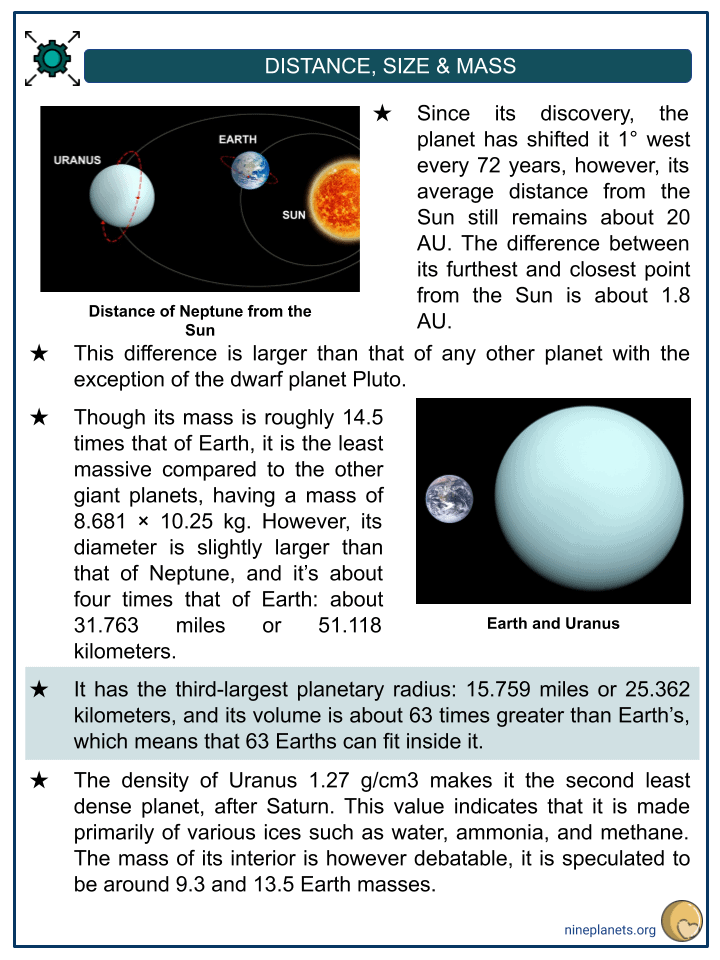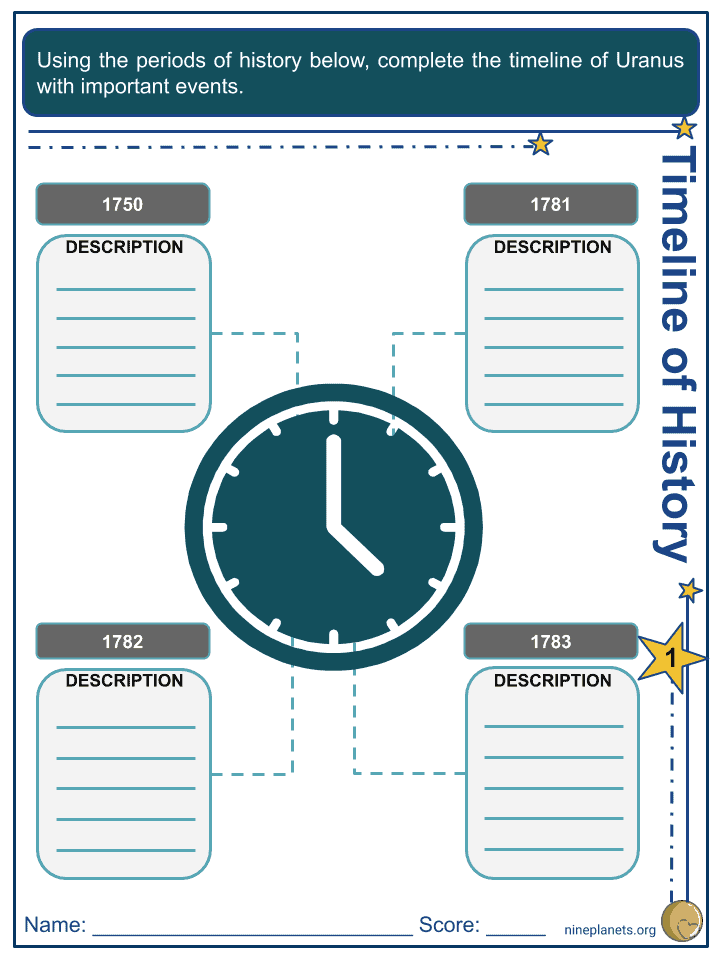Download Uranus Worksheets
Click the button below to get instant access to these premium worksheets for use in the classroom or at a home.

This worksheet can be edited by Premium members using the free Google Slides online software. Click the Edit button above to get started.
Download free sample
Not ready to purchase a subscription yet? Click here to download a FREE sample of this worksheet pack.
Resource Examples
Click any of the example images below to view a larger version.




Key Facts & Information
- Uranus is the seventh planet discovered in the Solar System that also led to the discovery of the last planet, Neptune. It is referred to as an ice giant because it has a hydrogen upper layer, which has helium mixed in. It is also the third-largest planet of the Solar System. It has the third-largest planetary radius and fourth-largest mass in the Solar System.
- Since ancient times, Neptune was not recognized due to its dimness and slow orbit. However, in 1781 Sir William Herschel announced its discovery being the first planet observed with a telescope.
- It was given the name Uranus, after the Greek god of the sky, Ouranos. It is the only planet whose name is derived directly from a figure of Greek mythology.
Quick Figures
- Surface Temperature: -197 °C
- Orbit Period: 30,687.15 Earth days
- Orbit Distance: 19.22 AU
- Known Rings: 13
- Known Moons: 27
- Equatorial Circumference: 159,354 km
Discovery
- The earliest definite sighting of Neptune was in 1690. John Flamsteed observed it six times, cataloguing it as 34 Tauri. Later it was observed for about fourteen times by Charles Le Monnier between 1750 and 1769. The man who finally solved this elusive object was William Herschel who observed it on 13 March 1781 with a telescope.
- By 1783, Herschel acknowledged that Neptune was not a comet but a planet. It took about 70 years after the planet was discovered for astronomers to arrive at a consensus. In 1782 Johann Bode proposed the name Uranus, the Latinized version of the Greek god of the sky, Ouranos.
- In other languages such as Chinese, Japanese, Korean and Vietnamese, Uranus is translated as “sky king star.”
Formation
- Through simulations after the Nice model, it has been suggested that both Uranus and Neptune formed closer to the Sun and later drifted away. It is hypothesized that the Solar System formed from a giant rotating ball of gas and dust known as the pre-solar nebula.
- Much of it formed the Sun, while more of its dust went on and merged to create the first proto-planets. As they grew, some accreted enough matter for their gravity to hold onto the nebula’s leftover gas. Estimates suggest the creation to have taken place about 4.5 billion years ago, and the drifting about 4 billion.
Distance, Size & Mass
- Since its discovery, the planet has shifted it 1° west every 72 years, however, its average distance from the Sun still remains about 20 AU. The difference between its furthest and closest point from the Sun is about 1.8 AU.
- This difference is larger than that of any other planet with the exception of the dwarf planet Pluto.
- Though its mass is roughly 14.5 times that of Earth, it is the least massive compared to the other giant planets, having a mass of 8.681 × 10.25 kg. However, its diameter is slightly larger than that of Neptune, and it’s about four times that of Earth: about 31.763 miles or 51.118 kilometers.
- It has the third-largest planetary radius: 15.759 miles or 25.362 kilometers, and its volume is about 63 times greater than Earth’s, which means that 63 Earths can fit inside it.
- The density of Uranus 1.27 g/cm3 makes it the second least dense planet, after Saturn. This value indicates that it is made primarily of various ices such as water, ammonia, and methane. The mass of its interior is however debatable, it is speculated to be around 9.3 and 13.5 Earth masses.
Orbit & Rotation
- It takes Uranus about 7 years to pass through each zodiac constellation, and a total of 84 years to make a complete trip around the Sun.
- The interior rotation of Uranus is completed in about 17 hours, 14 minutes, and as in the case of all the gas giants, its upper atmosphere experiences strong winds in the direction of rotation thus making a full rotation faster, in about 14 hours.
- The axis of rotation is approximately parallel with the plane of the Solar System, with a tilt of 97.77°. This feature gives Uranus completely different seasonal changes unlike those of other planets.
- Uranus is hotter at its equator than at its poles. However, speculations suggest that Uranus suffered a collision with an Earth-sized protoplanet about 3 to 4 billion years ago, while the solar system was forming.
Structure
- The standard model structure of Uranus consists of three layers: a rocky silicate/iron-nickel core in the center, an icy mantle in the middle and an outer gaseous hydrogen/helium envelope.
- The core’s mass is estimated to be about 0.55% Earth masses with a radius less than 20% of the whole of Uranus. The mantle comprises its bulk, with around 13.4 Earth masses. The upper atmosphere is relatively insubstantial, weighing about 0.5 Earth masses and expanding for the last 20% of Uranus’s radius.
- The core density is around 9 g/cm3, with a pressure in the middle of about 8 million bars, and a temperature of about 5.000 K. What is referred to as the ice mantle is not in fact composed of ice in the conventional sense, but of a hot and dense fluid consisting of water, ammonia and other volatiles.
- Uranus has no solid surface because of its fluid interior structure. Though it is the coldest planet in the solar system, it is not known why. Something prevents the heat of Uranus’s core from reaching the surface. It is believed that a form of barrier exists in the planets upper layers that stop the heat.
Atmosphere
- The outermost part of Uranus enveloped by gasses that is accessible to remote sensing is called its atmosphere. Uranus has no mesosphere, but its atmosphere can be divided into three layers:
- Troposphere. It is the lowest and densest part of the atmosphere, and the temperature decreases with altitude. The troposphere is thought to have highly complex cloud structures and is a dynamic part of the atmosphere, exhibiting strong winds, bright clouds and seasonal changes.
- Stratosphere. It has spanning altitudes between 50-4,000 km, with pressures between 0.1 and 10−10 bar. Temperatures gradually increase with altitude from 53 K in the boundary of the troposphere to between 800-850 K at the base of the thermosphere. The heating is caused by absorption of solar UV and IR radiation by methane and other hydrocarbons.
- Magnetosphere. The magnetic field of Uranus is peculiar, it does not originate from its geometric center, and it is tilted at 59° from the axis of rotation. The magnetic pole is shifted from the center towards the south rotational pole by as much as one-third of the planetary radius. A possible explanation of this peculiar magnetosphere alignment may be due to Uranus’s oceans of liquid diamond in the interior that would deter the magnetic field.
Moons & Rings
- Uranus has 27 satellites discovered. There are five main satellites that stand out: Miranda, Ariel, Umbriel, Titania and Oberon. However, they are small, even with the combined masses of all five they would still be less than half of Triton – the largest moon of Neptune.
- Uranus has thirteen distinct ring systems thought to have formed about 600 million years ago from the collision of possible other moons or big objects.
- The rings around Uranus are unique since they aren’t bright like the ones of Saturn. With this low albedo, they appear dark as charcoal. Another unique feature is that they are extremely narrow. The widest of the rings is called the epsilon ring, spreading from 20 to 100 kilometers wide. Their radii range extends from about 38.000 kilometers to 98.000 or 23.612 to 60.894 miles.